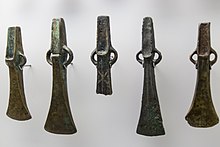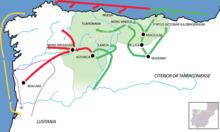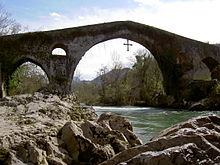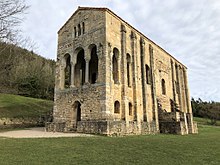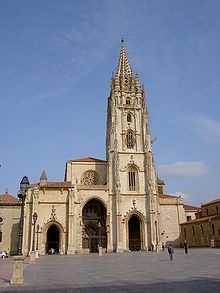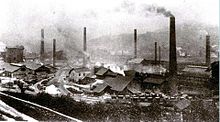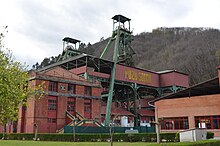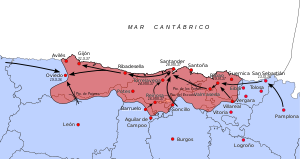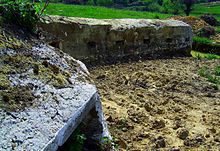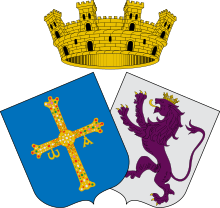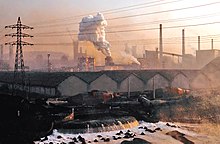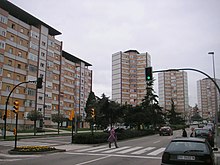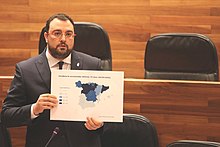History of Asturias
The history of Asturias covers the period from when Paleolithic tribes settled in this area of the Cantabrian fringe to modern post-industrial society. Regarding the etymology of the term Asturias, some authors believe that its origin is found in the name of the Astura River (today the Esla River), whose riversides were called astures by Roman authors..
Prehistory
Paleolithic
Asturias was occupied by human groups from the lower Paleolithic (100,000 years ago) in a period between Achalense and Musteriense. There are cave paintings that date from 30,000 years ago and correspond to the cultures.
<p of the Buxu (Cangas de Onís), of the Peña de Candamo (Candamo) and that of the Covaciella (Cabrales).Mesolithic: Asturian culture
In the mesolithic an original cultural one, the Asturian, typical of the East of Asturias and the west of Cantabria was developed. These settlements are found in mouths of caves close to the sea or low coats, generally close to the coast, although also in Cantabrian mountains of the interior.
Neolithic
of the Asturian Neolithic tests such as the thirty dolmens of the prehistoric necropolis of Mount Areo, between Carreño and Gijón, 5,000 years old, as well as mounds or the idol of Peña Tu (Llanes). At some point the previous cultures left the caves and dominated agriculture and livestock.
According to Avieno, in his description of the coast of the European West, the people who inhabit the peninsular north and the Atlantic coast to Brittany to Brittany were initially. They would be the descendants of some first inhabitants that would be a preindeuropeo town and other non -Celtic Indo -European. These were displaced by others that formed the Office (name that received the entire peninsular north): Cempsos, Sejes, Ligus and Draganos. Of these, the Drags would occupy the current Asturias and be the people of Celtic origin that invaded it.
Old Age
Castro culture
The period between the abandonment of the caves until almost the Romanization is quite unknown. Greek or Latin authors speak of barbarous and warlike tribes that lived in the jungles and mountains. Roman writers such as Pliny the Elder and Pomponio Mela and Greek writers such as Strabo speak of two main tribes separated by the Cantabrian Mountains: the Augustan Astures with their capital in Asturica (present-day Astorga) whose domains reached as far as the Duero, and the transmontano Astures that stretched between the Sella and Navia rivers. However, today it is understood that these divisions are the product of Roman practicality when establishing administrative and police systems, and not as a sign of precise indigenous identities.
There is also written evidence of the hard fights between the Astures and the Cantabrians along the riverbed of the Sella[citation required]. As well as the rudeness and bravery of both peoples and their resistance to being dominated by the Romans.
Samples of human presence in Asturias, such as the castros, belong to this period. Among them, the Coaña castro is an Asturian settlement built at the beginning of our era near the capital of the Coaña council. It lost importance from the III century and has been linked to gold mining in the Navia. Other prominent forts in Asturias They are Pendía (Boal), El Chao Samartín (Grandas de Salime), San Chuis (Allande), Os Castros (Taramundi), Cabo Blanco (El Franco), La Sobia and La Cogollina (Teverga), Campa Torres (Gijón), Caravia and so on up to a figure of around 300.
Romanization
At the end of the 1st century B.C. C. the Romans had the need to finish the conquest of the entire Iberian Peninsula. At that time only the northern peoples: Astures and Cantabros were not under the Roman yoke. The main motivation for imperial interest in this region was the gold found in the subsoil of the northwestern area of the peninsula, known to the Romans from Brutus's expedition against Gallaecia; also the young emperor Augustus needed some victory that would glorify his position.In the year 29 a. C. the vacceos, astures and cantabrians join in their fight against the Romans, and these concentrated all their military power in the north of the peninsula. César Augusto had to personally lead his troops.
Augustus carefully planned the war, creating extensive supply networks for his eight mobilized legions: I Augusta, II Augusta, IV Macedonica, V Alaudae, VI Victrix, IX Hispanensis, X Gemina and XX Valeria Victrix, totaling some 50,000 men. The complicated Asturian orography and the fierce Asturian resistance, organized through guerrilla warfare, prolonged the Roman invasion until 19 BC. C. Most of the war broke out between 26 and 22 a. C, having several battles such as the siege of Mount Medulio.
Always according to Greco-Latin sources, in the year 25 B.C. C. the Astures crossed the mountains of the Cantabrian Coast and camped on the Astura River (Esla River). Dividing their forces into three columns, they intended to attack as many Roman camps. Had it not been for the betrayal of the city of Brigaecium, which warned the Romans giving them time to reorganize and reject the attack, the Astures would have devastated the troops of General Publio Carisio. After suffering this defeat, the Astures took refuge in the oppidum of Lancia, which was attacked and occupied by the legacy of Lusitania.
However, this victory did not mean the end of the Asturian resistance. Indeed, the Romans had to deal with successive rebellions that periodically arose because of the treatment received from the invader or the levying of taxes. Thus, there were several rebellions in 24 BC. C, 22 a. C. and a last one in 19 a. C. that was the harshest reprisalized. Augustus, with the desire for a quick pacification, left the command of his troops to his best strategist: Agrippa.
Romanization began in a military way, securing the mountainous territory, riddled with fortifications, through camps such as La Carisa. Military control allowed a reliable extraction of precious minerals, especially in El Bierzo through the mines of Las Médulas, Already in Leon Large numbers of Astures were recruited into the Roman army to undertake defensive campaigns on the borders of the Roman Empire.
High Middle Ages
Visigothic Monarchy
The fall and dismemberment of the Roman Empire, which did not seem to have exercised much influence in the Asturian territory, occurred in the V. In the VI century, the invasion of the Peninsula by the Visigoths and Suevi is rejected by the Astures, therefore staying on the sidelines of Germanic cultural influence.
Between the V century and the VIII century, primitive Christianity settled in Asturias.
Asturian Monarchy (718-910)
<p It is at this time that the relics that are stored today in the Holy Chamber of the Cathedral arrive in Asturias. First they were kept in the Monsacro (Montes de Morcín) and then in Oviedo. This region never suffered intense Arabization, since the occupations by the Muslims were eventual and had more a character of Razzias .In 716 there was a first revolt against Muslim power in Asturias, under the command of a leader (probably noble) called Don Pelayo. This revolt was suffocated and Pelayo arrested and imprisoned.
Don Pelayo manages to flee in the year 717 of Córdoba, arrives at the Piloña River in 718 and that same year he manages to become chief of the Asturians, after talking and convincing the Asturian peoples of the need to join their forces front &# 34; to the common enemy ". In May 722 a second confrontation takes place in the battle of Covadonga against the Arab General Munuza. This was more a guerrilla victory than military. Don Pelayo, with the intention of consolidating his triumph, is proclaimed king in Cangas de Onís, founding the kingdom of Asturias.
The Asturian monarchy, as a result of several splits and regrouping, would give way in the centuries following the kingdoms of León, Galicia, Castilla and Portugal. From that moment and up to 1492 the Iberian Peninsula will be divided into a Muslim and another Christian part.
With Fruela, Oviedo became the capital. There, the abbot Máximo and his nephew Fromestano had built a Benedictine monastery on the ruins of a Roman fort. Castro that, in times of Augusto, protected the nearby city of Lucus Asturum (probably in the area of Lugones) and was located on top of the Obetao hill. Alfonso II the Chaste walled the city, built the primitive basilica of San Salvador and the basilica of San Julián de los Prados.
During the IX century between the reigns of Ramiro I and Alfonso III the Great, the following were built: San Miguel de Lillo, Santa María del Naranco, the church of San Salvador de Valdediós and Santa Cristina de Lena, the greatest examples of Asturian pre-Romanesque art.
The Kingdom of Asturias is divided after the death of King Alfonso III the Great, who divided his domains among three of his five children. These domains included, in addition to Asturias, the counties of León, Castilla, Álava, Galicia and Portugal (which was then only the southern border of Galicia). García kept the first two counties, founding the Kingdom of León. Ordoño II stayed with Galicia and Portugal, and Fruela II stayed with Asturias and later inherited the kingdom of León from his brother García I, who had no descendants.
Late Middle Ages and Modern Ages
After the union of the two kingdoms of Asturias and León, the capital passed to the well-walled and Roman city of León. With which Asturias became a remote and difficult-to-access region, only visited for the purpose of pilgrimages to Santiago de Compostela, when pilgrims on the Camino de Santiago deviated to Oviedo to visit the relics of the Cathedral.
Secessionist movements
The loss of this influence will spark various secessionist movements; One of the most important would be, in the XII century, the uprising of Count Gonzalo Peláez against King Alfonso VII and Urraca, who governed Asturias in the name of the King.
Origin of the Principality of Asturias
In 1388, through the Treaty of Bayonne, Juan I of Trastámara and Juan de Gante put an end to their disputes over the throne of Castile by agreeing to the marriage of their children Enrique III of Castilla and Catalina de Lancáster, a ceremony held in Palencia Cathedral. Both are granted the status of princes of Asturias, thus establishing the Principality of Asturias and the title that the heir to the Crown will hold from now on. In addition, a series of territories were linked to it in this way, which, due to their isolation, constituted a constant focus of rebellion.
In the early days of the institution, the Asturian territory belonged to the prince as patrimony and he could appoint judges, mayors, etc. who ruled in his name. This situation changed with the Catholic Monarchs, who reduced the title to an honorary status.
Asturias in the Castilian Civil War: 15th century
Asturias played an important role in the uprising that, after the death of Enrique IV, was started by King Alfonso V of Portugal in favor of the inheritance rights of his niece Juana and against Isabel la Católica. Alfonso V relied on discontented Castilian nobles and Isabel on the troops sent by Asturias and Vizcaya.[citation required]
At this time the old General Meeting of the Principality of Asturias appeared.
Baroque Asturias: 17th century
In the XVII century, Asturias presents a precarious situation started by a severe epidemic that began in 1598 and ended with a 20 % of the population. In 1693 there would be another pandemic. Despite these demographic blows, the Asturian population would have a growing development, especially on the coast and in the valleys. On an economic level, the entry of corn into Asturian agriculture, benefited by the climate rainy in the region, it would help rural subsistence economies. The Salense bishop Fernando Valdés Salas founded the University of Oviedo, which would come into operation in 1608 and during this period the works of the Oviedo Cathedral were completed.
Contemporary Age
Asturias during the War of Independence
When Napoleon Bonaparte invaded Spain in 1808 with the support of the afrancesados, the War of Independence began, the General Board of the Principality of Asturias chose to disobey on May 9 the orders coming from Madrid, where the executions had occurred of May 2, causing tension among Asturians and reason for disobedience. However, on May 13, the Board was frightened and told to pay attention to the French orders, in response, on May 25, 1808, a popular irruption declared the people of Asturias as sovereign in the Chapter House of the Cathedral of Oviedo. Thus, they take over several points in Oviedo such as the La Vega arms factory and constitute a new government body: the Supreme Junta. Soon they gather an army of more than 20,000 men from different councils, declare war on France, send a delegation to King George III and establish the precedent of the Central Supreme Board, coordinator of the different Supreme Boards of the Spanish territory.
Asturias during the Carlist Wars
Asturias was the scene of some battles during the First Carlist War (1833-1839), especially Oviedo, which was taken by General Gómez in the summer of 1835 after crossing the port of Tarna with a Carlist detachment of 2,800 men. However, after 3 days he had to leave the city due to the arrival of Espartero's troops. This event is probably the origin of the Oviedo gastronomic tradition of Disarmament Day. Another Carlist offensive occurred in September 1836, that of General Sanz, who took Llanes and Infiesto. He would try to besiege Oviedo but gave up and withdrew.In Gijón a wall was built from 1837 to defend the town, it would be demolished in the 1880s.
During the Third Carlist War between 1873-1876 the Carlists presented a better organization, although they were still defeated. The death in 1874 of the Carlist leader José Faes in Mieres, the main Carlist nucleus, stands out.
Illustrated Asturias
Mindset
In Asturias there was a centuries-old isolation. There was a lack of public education, which only fell on the privileged classes. The creation of the University of Oviedo in 1608, will not solve the problem because it is disconnected from the transformations in higher education that had been taking place in other places.
Even during the 18th century, despite the church relinquishing traditional hegemony in cultural and educational initiatives, the changes will not be profound. On the other hand, the press (gazets, newspapers, essays, etc.) so important in other places in Asturias will not be a dynamic element due to the absence of printing industries in the region. Thus the enlightened culture will only reach very small groups.
The enlightened minority tried to introduce their ideas through power (enlightened despotism), in Asturias they will be part of small sectors of the landed nobility and the clergy, that is, small and elitist circles of society that will meet in salons, gatherings and conferences and will maintain contact with the European intelligentsia.
Asturias brought important names to the Spanish Enlightenment: the first, Father Feijoo from Orense (1676-1764), precursor of the generation, the military writer Álvaro Navia Osorio (1684-1732), Marquis of Santa Cruz, the Catalan doctor Gaspar Casal (1680-1759), the economists and politicians José del Campillo y Cossío (1693-1743) and Flórez Estrada (1765-1853), the jurist and writer Martínez Marina (1754-1853), the history scholar Canga Arguelles (1771-1842), the politicians Count of Toreno (1727-1805) and Count of Campomanes (1723-1802) and closing the century the politician, economist, writer, historian, philosopher and essayist Gaspar Melchor de Jovellanos (1744-1811).
We can highlight two great enlightened men from this period:
- Benito Jerónimo Feijoo, a Benedictine father born in Orense, will undertake in the convent of Saint Vincent a research and study in various fields. During virtually all his life in Oviedo he will be a professor at the university between 1709 and 1764
- Gaspar Melchor de Jovellanos is the most representative figure of the Spanish illustrated movement. In addition to holding political positions as Minister of Grace and Justice (deposed by his reformist vision) he made important theoretical and practical contributions in economy, agriculture, teaching or theatre and public shows. The concern of Jovellanos for his land, a true asturianist, led him to carry out a multitude of companies in the region as the creation in 1794 of the first center of Spain in training experts in navigation and mining; the Institute of Nautical and Mining. It also planned a road to Castilla by Pajares, the carbon road and boosted the mining and industrial farms in Asturias.
Industrialization between 1852 and 1934
In 1852 the first section of the first railway line in Asturias was officially opened: The Langreo Railway, between Gijón and Langreo. This line, the third in Spain, served to transport the coal extracted in the Nalón basin to the port of Gijón. In 1874 a broad gauge railway was opened that would structure Asturias, the railway from León to Gijón, connected from 1884 with the Meseta through the Pajares ramp. 34 '"`UNIQ--nowiki-0000006E-QINU`"' and in 1894 another to El Entrego. The coal was either consumed internally or exported abroad of Asturias through ports, especially the port of El Musel, opened in 1907.
Between 1843 and 1849 the Asturian Mining Company would operate in the council of Mieres. It would be the predecessor of the three great steel mills of the century: The Mieres factory, founded in 1879 in Mieres, the La Felguera factory, dating from 1857 and the most important, and the Moreda factory, in Gijón, which began its activity in 1880.
However, the main industry in Asturias would be coal mining, developed in the Cuencas Mineras, central Asturias. Originating mainly in the mid-century XIX, it would live its golden age from 1914 due to the neutrality of Spain in the Great War and the protectionism of successive governments.
Asturias preserves a large number of elements of industrial heritage, especially the large number of Asturian headframes.
The Asturian labor movement 1890-1934
The Asturian working class is organized and in the 1890s the first socialist groups appear in Oviedo and Gijón and a little later in La Felguera and Mieres. In 1898 the first anarchist association arose and in 1881 the first workers' strike in Asturias, at the Llascaras and La Moral, Langreo wells. seconded by those from the Moreda factory, which will be disrupted by boss pressure. In 1906 the Mieres Factory began another unsuccessful strike. In 1910, the Mining Union (SOMA) was founded by Manuel Llaneza, which would be the most powerful union in the region. To counteract him, the Asturian Miners Employers' Association, promoted by the anti-workerist Marquis de Comillas, proposed Catholic union associations, which were not very popular.
The CNT, for its part, settled in the largest industry in the region, Duro Felguera, owners of the La Felguera Factory, and began a hard strike in 1912. Despite the differences, SOMA helped the strikers even though their puerile final agreements with the bosses increase the ties between anarchists and socialists. Despite the productive boom brought about by the Spanish situation in the First World War, the standard of living was considerably impoverished. That is why Asturias would actively participate in the great general strike of 1917; lasting 2 months on strike and being brutally retaliated by the Civil Guard, led by General Burguete.
During the following years, the Mining Union achieved some labor improvements (reduced working hours, wage increases...) and Manuel Llaneza asked the government for protectionist measures for the coal sector, which caused discontent among members of the consider it a movement of bourgeoisization, opening a period of internal conflicts in which Manuel Llaneza himself will be removed from the direction of the Union in 1921. In addition, part of the ranks go to the PCE.
During the Primo de Rivera dictatorship, trade unionism, especially SOMA, acquired a lower profile and softened its struggle, being a moment of precariousness for the mining population.
Revolution of October 1934
The 1934 Asturian Revolution was a labor insurrection that was part of the "revolutionary strike" and the armed movement organized throughout Spain known by the name of the October Revolution of 1934 and which only took root in Asturias, fundamentally due to the fact that there the CNT did join the Alianza Obrera proposed by the socialists of the UGT and the PSOE, unlike what happened in the rest of Spain. Hence, the form of social and political organization of the Asturian Commune (name by which the Revolution of Asturias is also known, due to its similarities with the Paris Commune of 1871) was the establishment of a socialist regime in the localities where the socialists (or communists) predominated, such as Mieres where the "Socialist Republic" was proclaimed; or like Sama de Langreo, or libertarian communism where the anarcho-syndicalists of the CNT predominated, as in Gijón and especially in La Felguera. It was harshly repressed by the radical-CEDA government of Alejandro Lerroux, against whom the insurrection had been launched for having given entry into the government to three ministers of the non-republican party CEDA, resorting, by decision of General Franco who directed the military operations from Madrid, to the Moroccan colonial troops (the regulars of the Army of Africa) and the Legion from Spanish Morocco.
The insurgents took over the neighborhoods of Oviedo close to the Cuenca highway and part of the old town (San Lázaro, Campomanes, El Fontán, Plaza del Ayuntamiento, and La Escandalera). The city garrison, supported by some civilians, took cover in areas of the city center. After five days of fighting and with the proximity of military reinforcements, the rebels withdrew after dynamiting the Holy Chamber of the cathedral, placing the dynamite in the crypt of Santa Leocadia, setting fire to the Campoamor theater, the University and several civil buildings.
After the electoral triumph of the left in February 1936 many of the prisoners of the uprising were amnestied and in July 1936 various army commanders rose up against the government that had just emerged from the polls.
Asturias in the Civil War (1936-1937)
During the War, Asturias was isolated from the central government and had to form its own Administration. Oviedo was occupied by Colonel Aranda, of the nationals, who maintained it until the end with the help of the corridor of Escamplero and Naranco through which supplies arrived. In Gijón the CNT and the FAI governed, there was no currency and there was a certain lack of coordination of the troops between the front and the rear. In that city, the Sovereign Council of Asturias and León was proclaimed on August 24, 1937. In October of the same year, several columns from the Villaviciosa front entered Gijón with almost no resistance and broke the siege of Oviedo.
The conflict will last for fifteen months, in which the main battles will be fought around the capital, besieged by the militiamen and on the limits of the region, Eo, Deva and the Cantabrian coast where the army offensives will seek to release the siege of the city.
The uprising
After the coup, the Republican forces were unable to prevail in the entire province, despite the fact that they are the majority, due to the support of the army chief in Oviedo, Colonel Aranda, for the rebels.
Colonel Aranda will delay his decision to support the uprising until July 19, taking enough time to make the Republican authorities believe his fidelity to the regime and gather the bulk of the military forces and Civil Guard of the province in Oviedo for his defense. Meanwhile, Colonel Pinilla, encouraged by Aranda, will revolt the Gijón barracks and the battle of the Simancas barracks begins.
From July to October 36
Both sides set their objectives: The republican government wanted to quickly put an end to the rebel foci, and the nationals would try to resist until the arrival of help, coming from Galicia through the so-called Galician column. On the government side, committees that will try to organize the militias arose in the first few days.
The union of the Provincial Committee with the CNT War Committee created in Gijón, after the uprising, will give rise to the formation of a new Provincial Committee, which will soon be called the Interprovincial Council of Asturias and León with headquarters in Gijón, directed by Belarmino Tomás and in which members of the PSOE, PCE, Izquierda Republicana and CNT will participate.
The rebels in the Gijón barracks will be defeated after 33 days of siege despite the help provided by the cruiser Almirante Cervera, which bombards the city from the coast. The Simancas barracks will fall on August 21, maintaining the square as Republican. For its part, Oviedo remains incommunicado, a situation that will last until October 17, the date on which the Galician troops led by Colonel Tejeiro penetrate the city through the corridor opened from Grado by the Escamplero. The militiamen who were besieging the center were unable to assault the last defenses despite the offensive carried out in the first days of this month.
October 36 to September 37
The arrival of the Galician column in Oviedo will open up a crisis between anarchists and communists, giving rise to the change of some advisers and establishing military victory over social revolution as a fundamental necessity.
To avoid the uncontrolled actions of the "red terror" of previous periods the People's Provincial Court is created. Meanwhile, Oviedo receives more aid thanks to the open corridor and the harsh living conditions of the besieged improve and the number of imprisoned and reprisals increases, which in the first months had been few. In February 1937 a new offensive was carried out in which Asturian and Basque battalions with Soviet weapons participated. It ends with a new failure despite the fact that it is possible to penetrate the city. In August 1937 a new Republican offensive is now directed towards the "Pasillo de Grado" trying to strangle the material aid that came to the capital, is also unsuccessful.
The fall of Vizcaya and the rapid rebel offensive towards Santander affected the battalions that besieged Oviedo and were sent to Cantabria. Santander falls causing fear among the members of the Interprovincial Council.
On August 24, 1937, the Interprovincial Council became the Sovereign Council of Asturias and León, an independent political entity with capital in Gijón. In this way, Asturias declared itself independent from the Republican government (the sovereign Council had its own ministers, currencies...) and increased its weakness before the insurgent front that was approaching in the east. On October 18, Villaviciosa fell and on October 21, Gijón, all of Asturias and the entire north remain in nationalist hands.
The demoralization in the days before the fall of Gijón was total, many of the most significant leaders fled from El Musel, which caused innumerable desertions and the "save who can& #3. 4;. Navy ships, merchant ships and even fishing boats are used to evacuate soldiers and civilians (some manage to escape the national blockade, others are captured and some, like the destroyer Ciscar, are sunk in the port itself). Other Republicans flee to Catalonia and some take to the mountains forming groups of guerrillas or "maquis" that last for a few years.
Postwar
Consequences of the war in Asturias:[citation required]
- Innumerable loss of materials, industries, deep-rooted fields (production declined in successive years to levels below those reached before the Republic between 20% and 29 %).
- Hunger and disease (tuberculosis).
- Destroyed buildings (in Oviedo 3/5 parts, including the cathedral and numerous churches and convents suffered serious deterioration.
- There are more than 16,000 deaths, 11,500 in combat (The number of deaths in Asturias is only surpassed by Madrid) and more than 5,000 reprisals.
- More than 2000 imprisoned during the early 1940s in prisons or work camps.
- Several thousand exiles.
In the post-war period, much of the working population remained in prison or had fled to the mountains, which forced the maintenance of a military force in the region. But with the declaration of World War II in 1939, coal and the metallurgical industry took on extraordinary importance, which prompted the revival of the region.
Asturias between 1939-1981
Asturias during the Franco regime was subjected to great economic and demographic growth supported by industry and mining. In 1957 Francisco Franco inaugurated the first blast furnace of ENSIDESA, a steel company belonging to INI. This steel mill had been planned from 1945 and construction began in 1954 to the east of the urban area of Avilés. For its part, the 3 privately-owned steel companies, Fábrica de Mieres, La Felguera and Moreda-Gijón, joined in May 1961 under the name of UNINSA and they agree to build a new plant to the west of Gijón, which begins to operate in 1971 in addition to the old 3 historic factories, which were due to close. However, after 2 years of activity, UNINSA adhered to ENSIDESA, in 1973, forming a state mega-factory between both factories. The disappearance of the steel company in the Cuencas Mineras caused migratory changes between the Cuencas and Avilés and Gijón. They would continue to maintain their mining predominance at this time. However, there would be a mining strike in 1962, it was successful although repressed.
In 1948 construction began in Gijón on the Labor University, which since its opening in 1955 will be the place of professional training for thousands of Asturians.
On July 11, 1968, the Asturias Airport was inaugurated, in default of the La Morgal aerodrome. In 1976, the "Y Griega" opened, the first Asturian highway that would connect Avilés, Oviedo and Gijón through a system of 3 branches united in a road link in Serín. It is currently part of the A-66 and the A-8. All these and more advances in the region would be exhibited at FIDMA from 1963, a technical, commercial, industrial and tourist showcase for Asturias.
Asturias since the Transition (1981-Present)
Industrial conversion
This period is marked in Asturias by a strong industrial conversion. Practically all sectors are affected by workforce cuts and closures. The industrial reconversion, dated approximately between 1986 and 1995 within the Government's plans for the European Union, caused enormous unemployment figures in Asturian cities, 24% in Avilés in 1988 and 26% in Gijón in 1987. In 1996, 123,000 unemployed were reached in Asturias. ENSIDESA, for example, would go from 21,012 workers in 1984 to 14,885 workers in 1990. However, it is still currently the largest company in Asturias, representing 23% of employment in 1993 Asturian industrial company. It should be noted that in 1997 ENSIDESA was privatized and renamed Aceralia, owned by Luxembourg.
At the same time, there would be demographic stagnation and an enormous release of urban land, especially in Gijón and to a lesser extent Avilés and Las Cuencas.
Political Evolution
With the arrival of democracy in Spain, the Regional Council of Asturias was created as a pre-autonomous provisional body, chaired by Rafael Fernández Álvarez. On December 30, 1981, the Statute of Autonomy of Asturias was approved, which determined the creation of the uniprovincial autonomous community of the Principality of Asturias.
In May 1983, the first regional elections were held. Pedro de Silva Cienfuegos-Jovellanos, of the PSOE, was elected President of the Principality of Asturias. Pedro de Silva was succeeded by Juan Luis Rodríguez-Vigil (PSOE) in 1991, who had to resign in 1993 due to the Petromocho case. Antonio Trevín assumes the position of President of the Principality.
In the 1995 elections, the Popular Party obtained a simple majority in the Board of the Principality of Asturias and Sergio Marqués was elected President. In 1998, due to differences of opinion with his party, Sergio Marqués left the Popular Party and founded the Asturian Renovation Union, ruling in a minority until the 1999 elections.
In 1999 the PSOE obtained an absolute majority and Vicente Álvarez Areces was appointed President of the Principality of Asturias. Since July 22, 2003, he governs with the support of the IU and in 2007 he wins the elections again and, despite not obtaining an absolute majority, he again forms a government, continuing as president Vicente Álvarez Areces & # 34; Tini & # 3. 4;.
In 2011, Foro Asturias, a newly founded party chaired by Francisco Álvarez Cascos, won the elections, becoming the first democratic party to win the first elections it ran for. In 2012, Álvarez Cascos called new elections and was defeated, Javier Fernández Fernández, general secretary of the Asturian Socialist Federation of the PSOE, becoming president. In the 2015 elections, he revalidates his victory by governing in a minority with the support of the IU. On July 15, 2019, Adrián Barbón, of the FSA-PSOE, is elected president to date.
Facts of the 21st century
Asturias would see, thanks to industrial reconversion, a reformulation of its urban spaces with the construction of facilities such as the Oscar Niemeyer International Cultural Center (Avilés, 2011), the ZALIA industrial estate (Gijón, 2006), the Labor, City of Culture (Gijón, 2007), the Parque Prin shopping center (Siero, 2001) the Minera, Industrial, Oviedo-Villaciosa and Oviedo-La Espina interurban highways, the extension of the Port of Gijón (2012), the Pajares variant (2023), the Gijón Road Plan and the HUCA (Oviedo, 2014).
The Covid-19 pandemic in Asturias resulted in the death of more than 3,120 people. The Asturian economy was affected, although it was able to recover in subsequent years. Likewise, the region was affected by the economic impact of the 2022 Russian invasion of Ukraine.
Asturias is going through the XXI century with major demographic problems, with an aging population that threatens to drop below one million inhabitants population of the principality.


